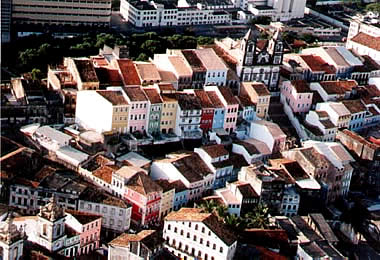Pelourinho

Aerial shot of Pelourinho
Pelourinho is an area that comprises some of Salvador‘ s oldest neighborhoods and shows the city‘ s expansion during the 17th and 18th centuries. Inventoried by IPHAN – National Artistic and Historical Heritage Institute and considered Humanity’‘ s Heritage by UNESCO, it is full of old houses that belonged to government authorities, rich sugar cane plantation owners, and wealthy businessmen. Nossa Senhora do Rosário dos Pretos church reaffirms the devotion started by Dominican priests on the African Coast, and composes the scenery at Largo do Pelourinho (Pelourinho Square), which takes the visitor back to a time of riches and ostentation. Some buildings in Pelourinho, such as Solar do Ferrão, hold some of the most important museums in the city, like Museu Abelardo Rodrigues, Fundação Casa de Jorge Amado, Museu da Cidade, Museu das Portas do Carmo, and Museu Tempostal.
Marcelo Bartolomei/Folha Imagem

Sight of Slope of Pelourinho, with the colorful houses and Church of Carmo
Nossa Senhora do Rosário dos Pretos Church - started in 1704 by Pelourinho‘ s Black Men Brotherhood, the construction of the temple lasted almost one century. The Black‘ s devotion to Nossa Senhora do Rosário comes from the African Dominican priests and got to the city with the slaves. Its frontispiece also presents towers covered with tiles; its inside also has tile pictures, with scenes of Rosário devoption in Lisbon.
Solar do Ferrão - building formed by the fusion of two houses in the end of the 17th century, it was the home of the Jesuit Seminar, and the laborer‘ s Circle. It currently holds IPAC‘ S headquarters (Bahia‘ s Artistic and Cultural Heritage Institute), and Museu Abelardo Rodrigues, whose access is through a beautiful and magnificent Portuguese ivory stairway.
Museu Tempostal - installed in a recuperated house in Pelourinho, it gathers picture and the country’s biggest postcard collection, with samples from all over the world between the 19th and 20th centuries.
Museu Abelardo Rodrigues - with Northeast‘ s largest saint collection, the museum exhibits religious objects that come from rural and urban homes from the 17th, 18th, and 19th centuries.
Casa de Jorge Amado Foundation - a center for the life and work of Bahian writer Jorge Amado, with pictures, books, and theses on the bibliography of Bahia‘ s most known novelist.
Museu da Cidade - with objects that represent the city‘ s 450-year-old culture, it brings distinct objects such as Mãe Menininha do Gantois chair, and sculptures of the Orixás (Candomblé divinities).
Museu das Portas do Carmo - exhibition of part of the old "Portas do Carmo Castle", in thew city‘ s northern boundary, part of the wall that surrounded the city during the 17th century, and some pieces from the old armory.
